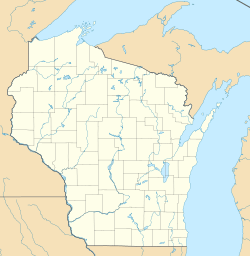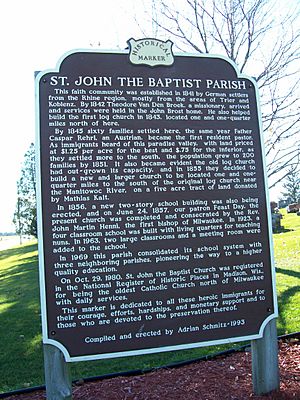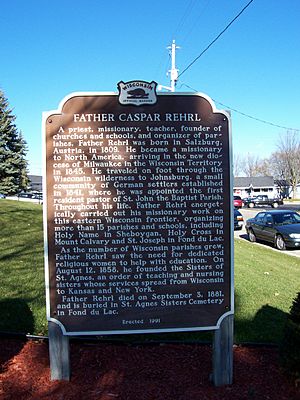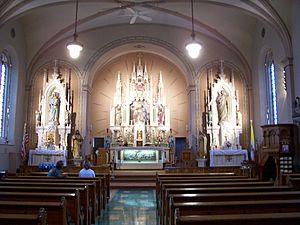St. John the Baptist Catholic Church (Johnsburg, Wisconsin) facts for kids
Quick facts for kids |
|
|
St. John the Baptist Catholic Church
|
|
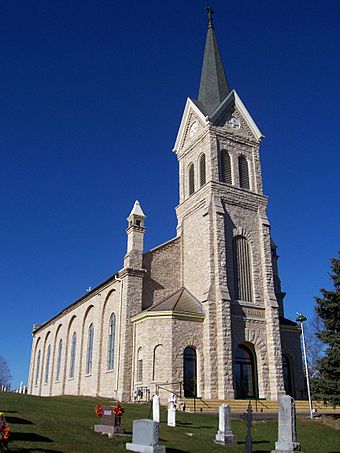
Church
|
|
| Location | N9288 Cty W, Johnsburg, Wisconsin. Located on County W just south of County Q. |
|---|---|
| Area | 0.4 acres (0.16 ha) |
| Built | 1857 |
| Architectural style | Romanesque |
| NRHP reference No. | 80000137 |
| Added to NRHP | October 29, 1980 |
The St. John the Baptist Roman Catholic Church is a historic church located in Johnsburg, a small community in Fond du Lac County, Wisconsin. It's part of the Roman Catholic Archdiocese of Milwaukee. This beautiful church was added to the National Register of Historic Places in 1980, meaning it's an important historical site.
Its story began in the 1830s with German immigrants who settled here. The very first church building was put up in 1843. The church you see today was built in 1857. The town of Johnsburg actually grew up around this church. Today, the church area also includes a school, a cemetery, and a rectory (where the priest lives).
Contents
A Look Back: Early Days of the Church
In the 1830s, immigrants from Prussia started making their homes in the Holyland region of Wisconsin. At first, they held church services in settlers' homes. Father Theodore Van den Broek led these early gatherings.
Church members generously gave 2 acres of land for a permanent church site. A small church made of logs was built there in the middle of 1843. Father Pete Carabin was named the first full-time pastor, but he didn't live in the area.
The Archdiocese of Milwaukee was created in 1843. St. John the Baptist Church has been part of this archdiocese ever since. Bishop John Henni, who was from Switzerland, visited the church. Parishioners were very happy to hear him speak in their native German language. A count in 1844 showed that 40 families belonged to the church.
In September 1845, Bishop Henni named Father Caspar Rehrl as the first pastor to live in the community.
Building a New Church
By 1850, the small log church was no longer big enough for everyone. People first thought about making the log church larger. But then they decided it would be better to build a brand new church.
A plan to build the new church to the south caused some disagreements among the church members. Father Rehrl resigned and moved to Mount Calvary. Father Bermadinger also decided to leave. He went to build a new church in nearby Marytown.
Father Leo Susan was pastor for about a year, then Father John Obermueller took over in 1851. By this time, the church had 200 families! The final decision was made to build a new stone church to the south. A parishioner donated 5 acres of land for it.
Some church members still disagreed with this plan. Bishop Henni came to help settle the arguments. Some of the disagreeing parishioners even started building a rival stone church at the old location. They used $700 that one of the Brothers had been given for a new church. However, the bishop did not approve this new building. Work stopped when the money ran out, with only the walls completed.
Father Obermueller was very frustrated and resigned in October 1853. The parish was without a priest until August 1854, when Father Michael Deisenrieder arrived.
Construction of the 1857 Church
Father Deisenrieder started gathering materials from nearby stone quarries. Bishop Henni laid the cornerstone of the new church in mid-1855. The church was built from very hard limestone. There was no architect or contractor, meaning people built it themselves. The church took more than two full years to complete.
Some of the disagreeing parishioners refused to help with the new church. Other members were too poor to contribute. A two-story school was also built at the same time.
The church was finished in 1857. A big festival was held to celebrate, and the new sacred building was officially dedicated. Several families built homes near the church, and that's how the community of Johnsburg began. Father Deisenrieder helped set up a post office. The town was first named Heinzburg, honoring his birthplace in Bavaria.
Father Deisenrieder's financial report showed a loss, and he faced some anger from the community. He resigned, and Father Maximilian Mueller became the head pastor in mid-1857. Sadly, Father Mueller was ill and died in July 1858 at age 33.
Years of Growth and Change
After a period of peace, a series of Capuchin priests helped lead the church. Bishop Henni named Father F.X. Pfaller as the full-time pastor in 1861. He stayed until May 1862. For a while, priests would only stay for about one year. Father Aloys Kieser was the preacher from 1866 until 1873.
Bishop Henni later sold the land where the original log church had stood. He made sure that the cemetery there would remain untouched. He also required that the unfinished stone church at the old site be torn down by April 1, 1874.
Improvements and New Buildings
Several priests led the parish until Father Julius Hellweger took over in April 1879. He stayed for a very long time, making him the longest-serving pastor in the church's history up to 1980. Father Hellweger had left Germany to avoid the "Kulturkampf", which was a time when the government was persecuting Catholics.
Father Hellweger made many changes to the church. The inside walls were plastered, as they had only been whitewashed stone before. A vaulted ceiling was added, new flooring was put in, and beautiful stained glass windows were installed. New equipment was also added, like a new confessional, a higher altar, and a sanctuary lamp.
In 1882, the church celebrated its 25th anniversary. A new roof and heating system were installed. In 1884, a new two-story school made of cream-colored brick was built where the old school had been. It was finished in 1886. In 1889, Father Hellweger raised money for a pipe organ and then a metal fence around the property.
Archbishop Frederick Katzer visited in 1892 and encouraged the parishioners to build a new tower. A Milwaukee architect named Robert Messmer was hired, and the new tower was completed by 1894.
A rectory (priest's house) was built in 1905 or 1906. The church was named an outpost of the Milwaukee archdiocese when the diocese lines in the state were redrawn.
During World War I, there was a strong feeling of anti-German patriotism in the United States. However, the men of the parish voted 40 to 34 to keep sermons in German. Even during the Great Depression, the parish was able to make some improvements. These included a tile floor in the sanctuary, a tabernacle, two statues, two furnaces in the school, and a garage for the rectory.
Modern Times and School Changes
Father Benjamin Blied became the pastor in 1948. During his time, a deeper well was dug, automatic bells were added, and the old school was torn down to make a playground. A powerful heater for both the church and school was installed.
On John the Baptist's day in 1957, the church building celebrated its 100th anniversary with a special mass. Many priests who grew up in the parish took part in the celebration, which was led by Archbishop Albert Gregory Meyer. Later that year, more improvements were made. The school yard and church paths were paved with asphalt. The steeple was repainted, and its clock was removed and replaced with windows. The church floors were also tiled.
Father Blied left in 1960 to teach at Marian College. Rev. Robert Bier took his place.
Forming a Consolidated School
The school was taught by nuns, and they wanted to move their living quarters out of the school and into a separate convent. This would help with overcrowding in the school. The idea was approved in 1961, but it took until late 1963 to finalize plans because of issues with designing a good sewage system.
After the convent was completed, the New Holstein School District rented two rooms at the school for five years. Parishioners realized that other Catholic private schools in the area were having trouble finding non-nun teachers.
A series of meetings were held, and state officials talked about school funding. Four schools decided to combine: Marytown, St. Cloud, Mount Calvary, and Johnsburg. St. Joe declined to join. St. Anna was interested, but it was in a different diocese and joined too late in the planning.
They couldn't decide on a name for the new school. So, the treasurer eventually had checks made using the name "Consolidated Parochial Elementary School," and the name stuck! Starting with the 1969-70 school year, students from Marytown and Johnsburg in Grades 4 to 8 were taught at Johnsburg.
Today at St. John the Baptist
The school building became the home of Holyland Catholic School in 2015. In the late 2010s, St. John the Baptist Church joined four other nearby churches. Together, they formed Our Lady of the Holyland parish under the Milwaukee Archdiocese.
Church services are held at St. John the Baptist on Sunday mornings at 10:30. The current pastor is Father Paul Koenig, OFM Capuchin.


